Lifestyle
8 L.A. happenings in May to get you ready for summer

Balenciaga’s Le City bag is bringing back the early aughts
Fashion is in love with the early 2000s right now, and Balenciaga, the Kering-owned brand, has brought back the signature Le City bag, which was introduced in 2001. The new bag, which comes in small and medium sizes with adjustable shoulder and crossbody straps, is available in black, yellow, green, light purple, metallic steel gray, metallic silver, white, blue and beige. The style and construction of the new versions of the bag — studs as well as leather-strung zipper pulls and rivets are included — were inspired by the archival bags. A small Le City bag is $2,350, while a medium bag goes for $2,850. (The small metallic silver Le City bag is $2,390 and the medium version is $2,900.) The bags are sold at balenciaga.com and in select stores. Also, as part of the reintroduction, a campaign featuring portraits of Kate Moss, Danish model Mona Tougaard, Chinese actress-singer Yang Chaoyue and Korean singer Juyeon was shot by fashion photographer Mario Sorrenti.
Kinn Studio and Almina Concept collaborate on first retail space
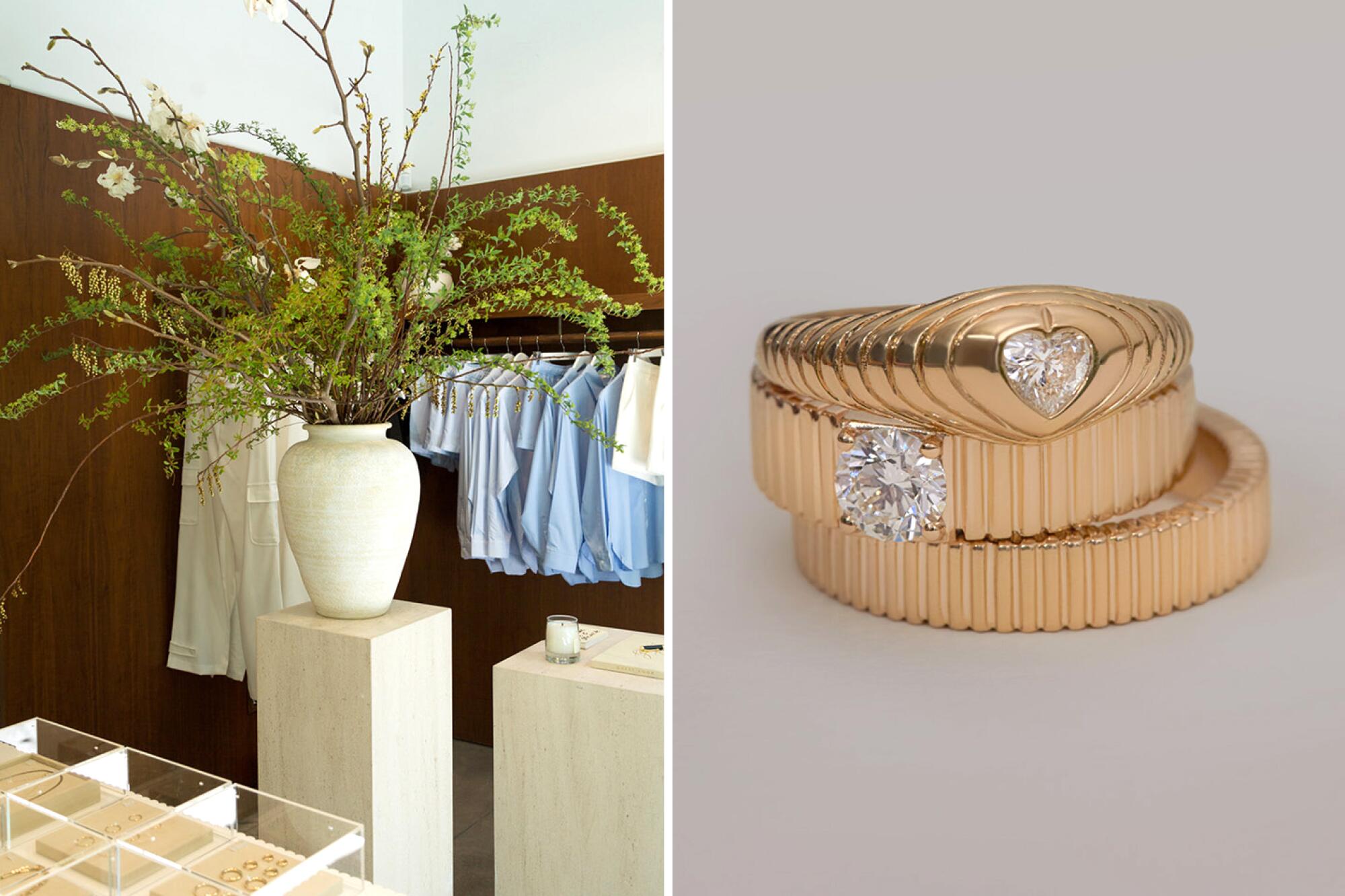
(Lauren Moore / Design Assembly; Kinn Studio)
Jewelry label Kinn Studio and womenswear brand Almina Concept have collaborated on a new six-month pop-up space at mini style mecca Platform in Culver City. It’s the first bricks-and-mortar space for each brand. AAPI founders Jennie Yoon of Kinn Studio and Angela Gahng of Almina Concept wanted to give shoppers a personalized experience while acknowledging L.A. and their Korean heritage. You’ll find fine jewelry and vintage watches from Kinn Studio along with Almina Concept’s contemporary fashion pieces, which are made in Seoul, South Korea. The look of the minimalist shop was created by L.A.-based interior designer Lauren Moore of the Design Assembly. 8850 Washington Blvd., Culver City, kinnstudio.com, almina-concept.com
‘Louis Vuitton: A Perfume Atlas’ explores the world of fragrance

Louis Vuitton is giving customers and readers a look at how its fragrances are made with the release of the book “Louis Vuitton: A Perfume Atlas” ($160, Thames & Hudson), which captures Louis Vuitton master perfumer Jacques Cavallier-Belletrud as he searches globally for ingredients used for the French brand’s fragrances. Through illustrations, photography and text, the 380-page book covers how flowers are cultivated, the seasons for growing and the techniques used at harvest. It also explores how essential oils are extracted and used to create fragrances. The book, which comes in three cover offerings (rose, lemon and jasmine), is by Cavallier-Belletrud and co-author Lionel Paillès, illustrator Aurore de la Morinerie and photographer Sébastien Zanella. Also, the limited-edition “A Perfume Atlas” box set ($5,000, in-store only) includes 45 vials with extractions of raw materials selected by Cavallier-Belletrud. The book is available at louisvuitton.com and book retailers.
Cartier renovates and reopens its South Coast Plaza store
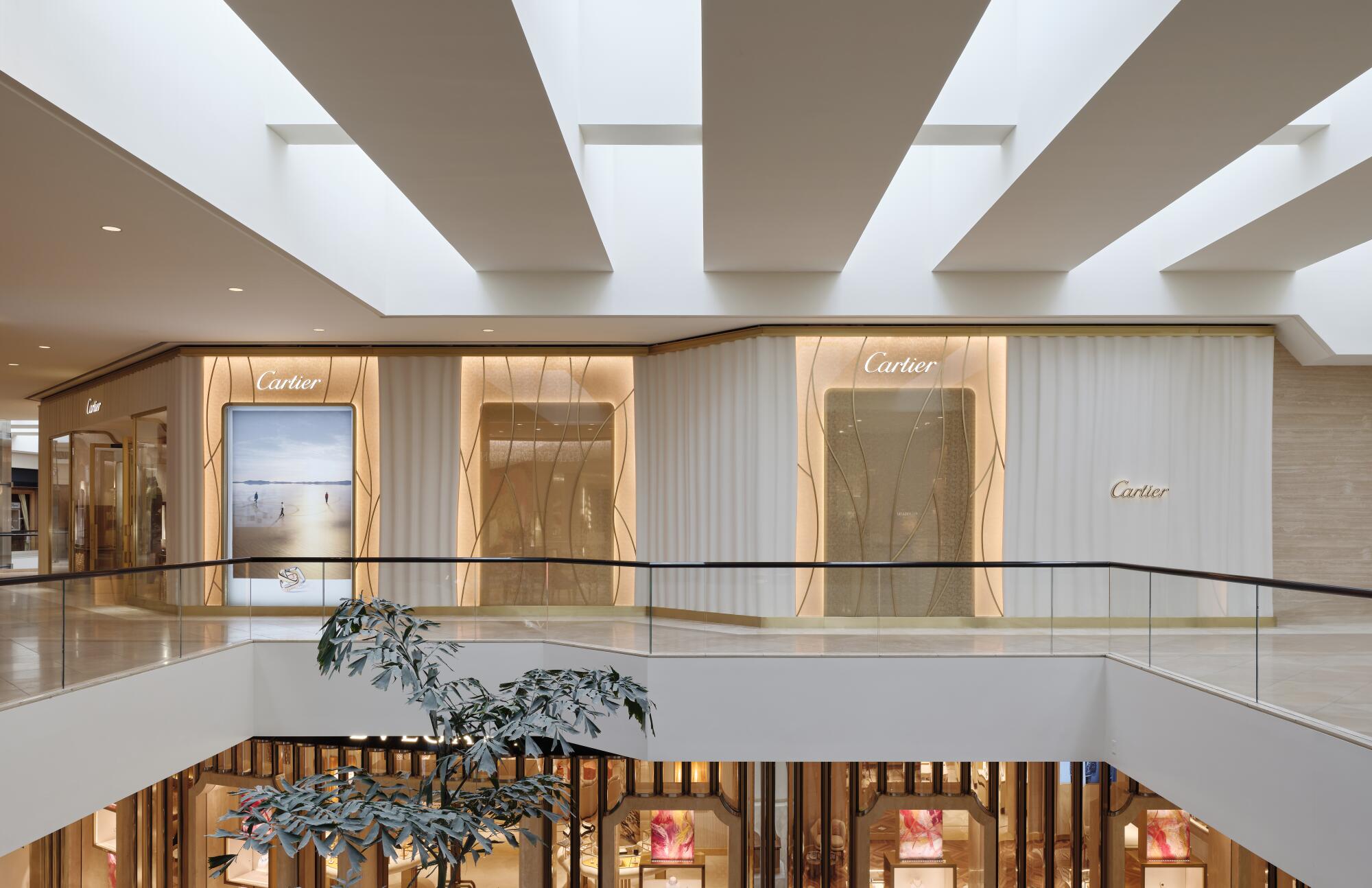
Luxury house Cartier’s renovated and expanded boutique at South Coast Plaza in Costa Mesa celebrates all things Orange County and Southern California. The Moinard Bétaille agency, which has collaborated with Cartier for decades including on the flagship store in Paris, took inspiration for the elegant revamped space from SoCal’s varied landscape and terrain. (Think Newport Beach and Laguna Beach meets Mojave Desert and Joshua Tree.) As you enter the store, which reopened in April, the first things you’ll likely notice are the three-dimensional facade as well as the large panel featuring a panther by François Mascarello. In the boutique’s mix of fine jewelry, watches, leather goods, fragrances and more, you’ll also find local flora, palm tree-inspired handcrafted staff columns and a hand-painted Moss & Lam mural. And don’t forget to spot the lacquer and mother-of-pearl panel by Atelier Midavaine in the bridal area, the dahlia-shaped custom chandeliers in the space and the Lasvit glass canopy light, which was inspired by the area’s skate parks. 3333 Bristol St., Costa Mesa, cartier.com
‘Mickalene Thomas: All About Love’ arrives at the Broad
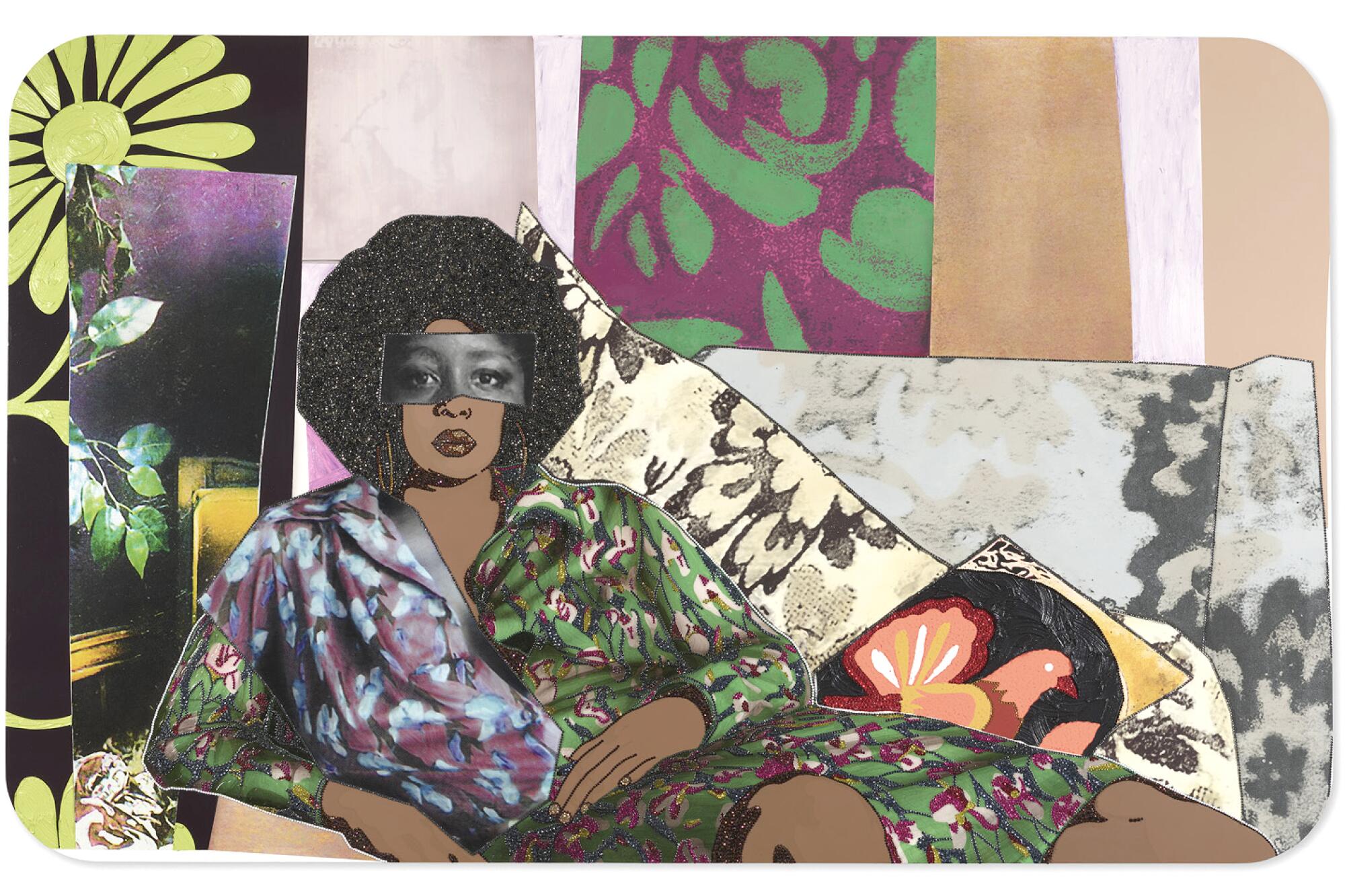
Mickalene Thomas, “Afro Goddess Looking Forward,” 2015, rhinestones, acrylic, and oil on wood panel, 60 x 96 x 2 in.
(Mickalene Thomas)
In these challenging times, the “Mickalene Thomas: All About Love” exhibition at the Broad could be the antidote we need for healing and redemption and truly being able to love others and ourselves. After all, the exhibition takes its name and several themes from the acclaimed bell hooks text centering around the question, “What is love?” As the first international tour of Thomas’ work, this showcase features more than 80 works from the last two decades and examines topics including beauty, politics, memory, erotica and sexuality, with a focus on the people who have been marginalized and excluded in art history. In the exhibition, you’ll discover mixed-media painting and collage, photography and more, including large-scale works, from the innovative Camden, N.J., native. The exhibition’s themes also are part of fresh programming in collaboration with Thomas, with a summer concert series in the works and in-gallery programs focused on women and Black and queer communities. “Mickalene Thomas: All About Love,” which was co-organized by the Hayward Gallery in London, the Broad and the Barnes Foundation in Philadelphia, runs from May 25 to Sept. 29. 221 S. Grand Ave., Los Angeles, thebroad.org
‘Simone Leigh’ exhibition comes to LACMA
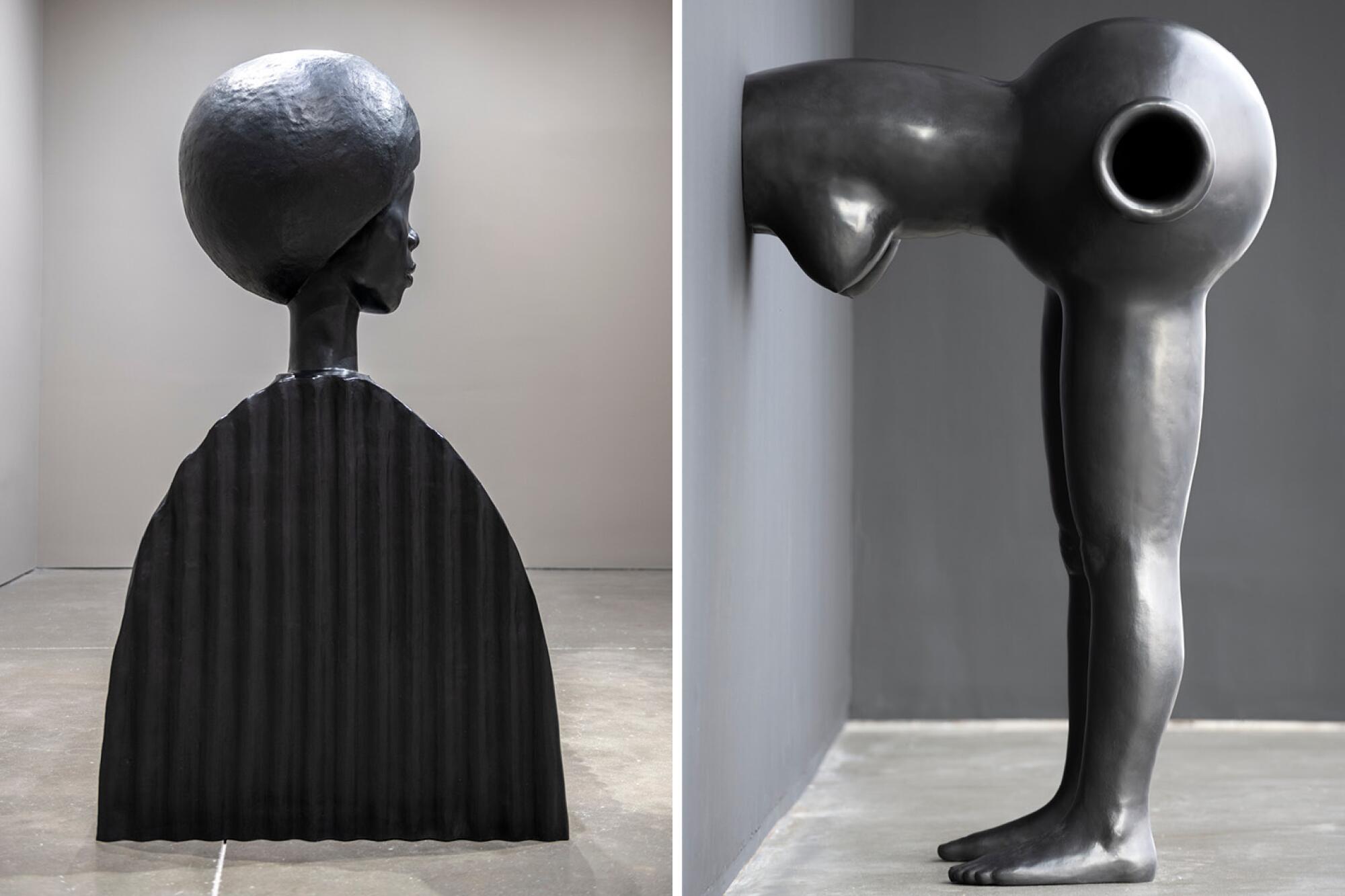
Simone Leigh, “Sentinel,” 2019. Right, “Dunham,” 2023, courtesy artist, Matthew Marks Gallery.
(Timothy Schenck)
The exhibition “Simone Leigh” is the first comprehensive look at the artist’s work, with the Los Angeles County Museum of Art showcase featuring about 20 years of the artist’s production in ceramic, bronze and video in addition to her powerful 2022 Venice Biennale presentation. According to a synopsis from LACMA, Leigh has continued to explore questions around “Black femme subjectivity and knowledge production” as well as addressed “historical periods, traditions and geographies with her art referencing vernacular and hand-made processes from across the African diaspora, as well as forms traditionally associated with African art and architecture.” “Simone Leigh,” a traveling exhibition that was organized by the ICA Boston and co-presented in SoCal by LACMA and the California African American Museum, runs from May 26 through Jan. 20. 5905 Wilshire Blvd., Los Angeles, lacma.org
Michael Kors Collection returns to Beverly Hills
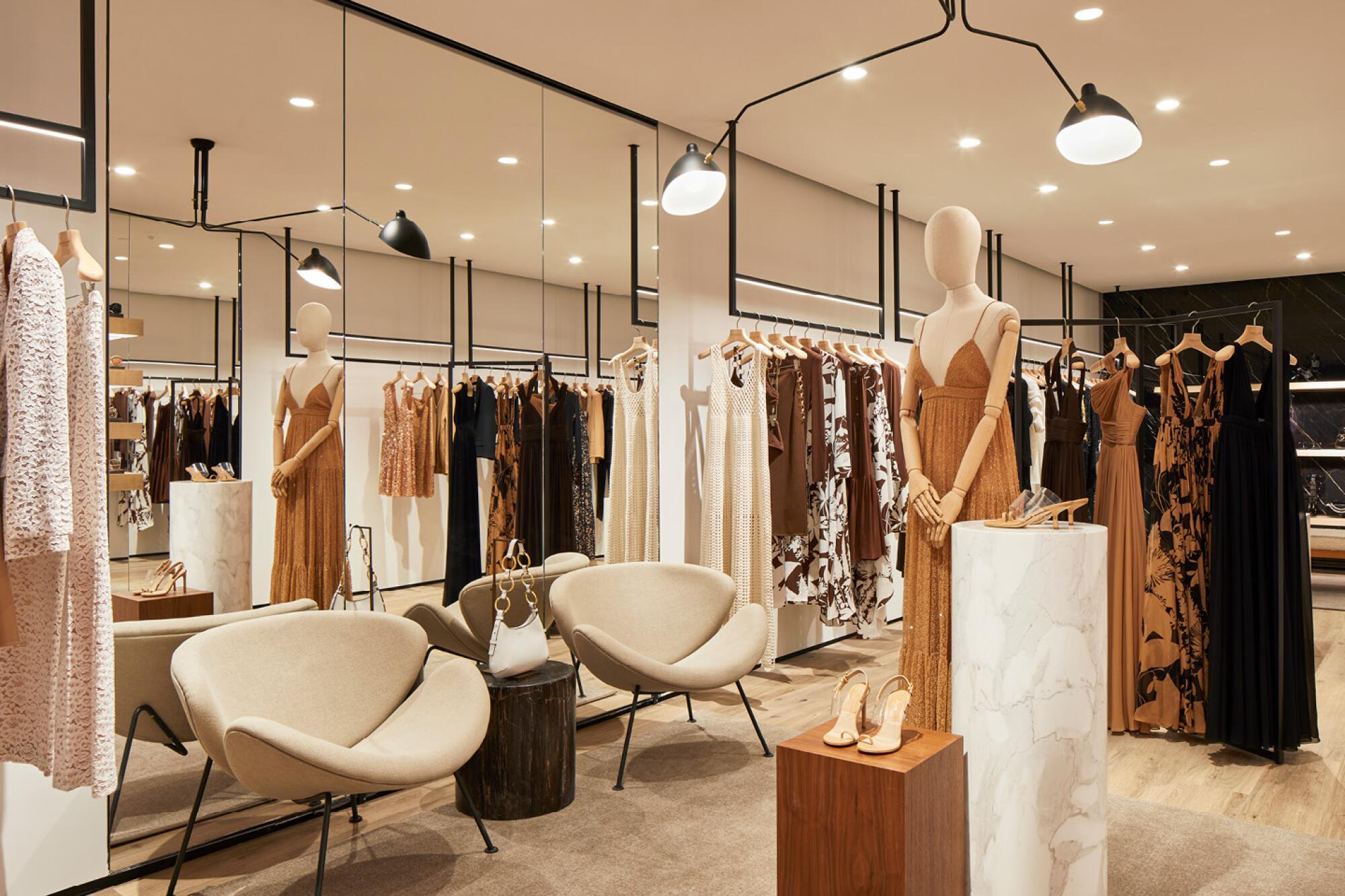
(Michael Kors Collection)
Designer Michael Kors is having a full-circle moment by bringing his Michael Kors Collection boutique back to Beverly Hills after a nearly four-year hiatus. The new two-level space, which recently opened at the European-inspired Two Rodeo Drive, has a spare yet luxe residential vibe thanks to a large video wall, blackened steel, raw concrete, antique brass, gold Calcutta marble, oxidized maple and natural light. (This is the North American debut of this new Collection store concept.) In the stylish mix, look for women’s pieces from the spring and summer collection and other goods at street level along with handbags and other accessories on the lower floor. 242 N. Rodeo Drive, Beverly Hills, michaelkors.com
Billy Reid opens a new Venice store

Designer Billy Reid is thrilled by his brand’s 12th store location — this one on Abbot Kinney Boulevard in Venice. That’s because, although he has Southern roots, Reid, a Council of Fashion Designers of America multiple award winner, spent four years living in Los Angeles. The new SoCal outpost also allows Reid’s luxe brand to connect with customers face-to-face, after having built L.A. into one of the brand’s biggest markets largely through e-commerce. The store will carry the men’s and women’s collections as well as accessories — all within a space that features Reid’s take on modern Southern decor along with tall ceilings, exposed trusses and brick, and a large glass storefront. The look of the space includes Turkish rugs, various artworks and a large bookshelf spanning the back wall. 1351 Abbot Kinney Blvd., Venice, billyreid.com

Lifestyle
Prize-winning Bulgarian writer brings 'The Physics of Sorrow' to U.S. readers


Bulgarian writer Georgi Gospodinov won the 2023 International Booker Prize for his book, Time Shelter. An English version of The Physics of Sorrow, an earlier novel, has just been published in the United States.
Toward the end of this brilliant book, Gospodinov considers the concept of “weight” in physics. He writes, “The past, sorrow, literature — only these three weightless whales interest me.” This complex sentence provides a summation of Gospodinov’s fascinating literary explorations.
Elegantly translated by Angela Rodel, The Physics of Sorrow is a fragmented novel that coheres into a remarkable, thought-provoking whole. It is a winding labyrinth through Bulgarian communism, art, literature, history, the personal past, love, sorrow, and so much more.
In epigraphs, Gospodinov invokes Argentine writer Jorge Luis Borges and Portuguese writer Fernando Pessoa, members of the tradition in which Gospodinov writes. At the same time, he quotes St. Augustine, Gustave Flaubert, and his own fictional character Gaustine, signaling to readers not to take anything too seriously, but also to consider the weight of each word.
Gospodinov frames his novel around the myth of the Minotaur, a monster with a bull’s head and a man’s body, captive in an underground Labyrinth on Crete. There are multiple variations of the myth, and multiple explanations of how the Minotaur came into being. Gospodinov parses through many of them, like a gourmet cook selecting produce. He considers how aspects of this myth are imprinted on modernity — man behaving as beast and society “othering” those who are different.

Gospodinov’s narration is fluid. Sometimes he writes in first person, sometimes a boy/man named Georgi (like the author) narrates, sometimes the narration is in third person. We get insights into Gospodinov’s reading and writing life. “At five I learned to read, by six it was already an illness … literary bulimia.” He leaves a blank space on a page, saying it was written with invisible fruit ink. “What, so you don’t see anything? …If only I could write a whole novel in such ink.”
If there is a plot, it is composed of the arcs of several lives, including a person like the author himself and a person who may be like his grandfather. We get characters’ memories from World War I, and World War II, which could be Gospodinov’s own family stories.
The Physics of Sorrow, however, is not a novel to read for plot. It is a book that raises vexing questions about the human condition, and travels down labyrinthine digressions about topics that consume us — life, death, social woes, war, peace, old age, youth. And perhaps the creation of literature, above all.
For Gospodinov, time is an artifice. Present, past, and future slide around like pieces on a chessboard. A section called “The Chiffonier of Memory,” exemplifies Gospodinov’s technique. Here, the narrator — perhaps the author — is a journalist writing about Bulgarian WWII cemeteries. He travels through Serbia on the roads his grandfather “trudged on foot through the mud in the winter of 1944,” before stopping in Harkány, Hungary to interview a man who lives in a house where his grandfather was billeted during the war.
The man comments on his mother, an old woman present at the interview, as an occasion to explore memory: “Her memory is a chiffonier, I can sense her opening the long locked-up drawers … she has to wade through more than fifty years, after all.”
The man is ill at ease with his mother’s silence. He asks her something. “She turns her head slightly, without taking her eyes off me [the narrator]. It could pass as a tick, a negative response, or part of her own internal monologue.” The man notes that since his mother had a stroke, her memory is not all there.
But the narrator is having a different experience. He ignores his interviewee’s comments, certain that the woman recognizes him because he looks just like his grandfather.
The narrator jumps through time to describe how beautiful this woman was as a young woman, and how much his grandfather loved her. Even though the narrator was not there, he describes what she looked like and what she wore, projecting his grandfather’s love affair — which may or may not have happened — as his own.
Even though the narrator and the old woman have “no language in which we can share everything,” her eyes say in “impeccable Bulgarian: hello, thank you, bread, wine … I continue in Hungarian: szép (beautiful) … as if passing a secret message from my dead grandfather.”
Who has actually experienced this love affair and who is the narrator? The passage may read as linear story, until the reader stops to consider the enormous gap between the time of the interview and the time of the love affair.
The book purports to be about sorrow, and it is. Sorrow laces through life in many guises — grief, abandonment, regret, guilt. For this reader, Gospodinov’s multi-faceted considerations of human (and mythical) sorrow are reason enough to read the book.
At one point, Gospodinov writes that he aspires to “keep a precise catalogue of everything.” It feels like he has nearly succeeded with this innovative, captivating novel.
Martha Anne Toll is a DC based writer and reviewer. Her debut novel, Three Muses, won the Petrichor Prize for Finely Crafted Fiction and was shortlisted for the Gotham Book Prize. Her second novel, Duet for One, is due out May 2025.
Lifestyle
We’re transitioning into Gemini, and Rick Owens won’t let us lose our house keys

(Beth Hoeckel, featuring “Silver Gemini keychain” by Rick Owens)
This story is part of Image’s May issue, Homemaking, about home and the many ways we choose to make it.
In this sunny, gloomy town, it’s not just that things are often not as they seem — they are more than. Excess competes with restraint for the same parking spot, and they keep promising each other they’ll get lunch (neither can decide if they want to follow through). Youth and experience attend the same cocktail hour, and both leave early — one, to not miss the last bus to the Eastside; the other, to be well rested for 7 a.m. hot Pilates. To make a home of this metropolitan desert oasis requires a certain cognitive dissonance, a willingness to accept that multiple worlds will nest into each other simultaneously forever and there’s nothing you can do about it (nor would you want to). After all, the dapple of sunlit pool water reflected on the underside of a patio umbrella on a 75-degree day in June is just the mirror image of a grimy, chilly May fog crystallized on the palm trees lining cracked asphalt streets. Thanks to the ever-providential mercurial gods, we have been granted permission to leave either/or in Taurus season. Everybody knows Gemini season is for both/and.
Anyone who has ever tried to make a home of a Gemini (another kind of desert oasis) understands, for better or worse, that their beloved is an enigma of contradictions that somehow make all too much sense when looked at as the sum of a kaleidoscopic whole. It is in the spirit of this supple duality that we encounter the Rick Owens Silver Gemini key chain, aptly and concisely named as such because, well, isn’t it obvious?
Homemaking is an art, a craft, a practice, a burden, a necessity, a privilege.
A smooth brass circle meets a confident silver-tone rectangle in a holy geometric union that could inspire a passive allegory of the masculine-feminine from a less inventive mind (sorry, Virgo). But for our intents and purposes, we consider the tool (the apparatus?) of the key chain more intently, more deeply. It is a vessel intended to be secure, assumed to be trustworthy, the bearer of the most treasured of quotidian possessions that simply cannot be misplaced, at the risk of inconvenience at best, a catastrophe at worst. It’s funny how we just trust these pieces of metal to guard other pieces of metal, our access to our dwellings, our most intimate and vulnerable places.
Homemaking is an art, a craft, a practice, a burden, a necessity, a privilege. It’s in the talismans that we arrange within our homes, from the haphazardly purchased necessities to the carefully considered luxuries. It’s the memory of a past lover washing a wine glass stolen from the dive bar down the street after Sunday night supper, a dusty paw print left by a familiar venturing into a forgotten crevice. Homemaking can be taken care of, obsessively attended to or ignored altogether — it is Gemini season, after all, and that means we can do what we want. But the making of a home is something we are all compelled to consider at one point or another. And, amazingly, it all starts with a key, a tiny piece of carved metal, which, like all of us, needs something to keep it safe — even if that something contains as many multitudes as the city herself.
Goth Shakira is a digital conjurer based in Los Angeles.
Lifestyle
Tony nominee Jocelyn Bioh puts braiders centerstage : It's Been a Minute

-

 News1 week ago
News1 week agoSkeletal remains found almost 40 years ago identified as woman who disappeared in 1968
-

 World1 week ago
World1 week agoIndia Lok Sabha election 2024 Phase 4: Who votes and what’s at stake?
-

 World1 week ago
World1 week agoUkraine’s military chief admits ‘difficult situation’ in Kharkiv region
-

 Movie Reviews1 week ago
Movie Reviews1 week agoAavesham Movie Review
-

 News1 week ago
News1 week agoTrump, Reciting Songs And Praising Cannibals, Draws Yawns And Raises Eyebrows
-

 World1 week ago
World1 week agoCatalans vote in crucial regional election for the separatist movement
-

 Movie Reviews1 week ago
Movie Reviews1 week agoUnfrosted Movie Review: A sweet origins film which borders on the saccharine
-

 Politics1 week ago
Politics1 week agoNorth Dakota gov, former presidential candidate Doug Burgum front and center at Trump New Jersey rally


















